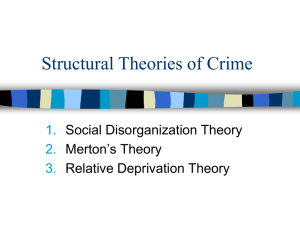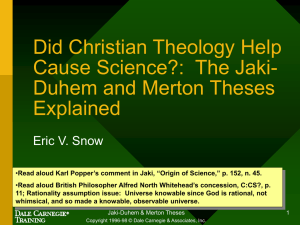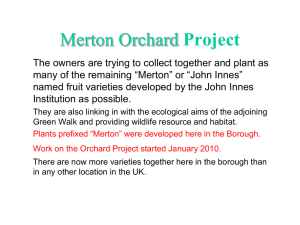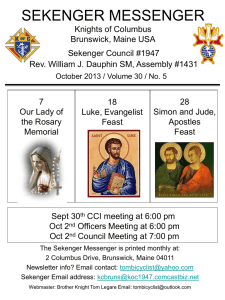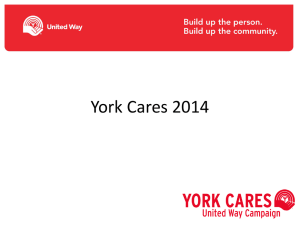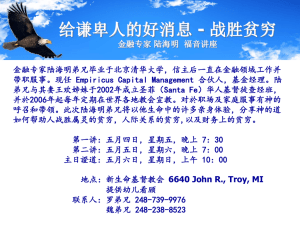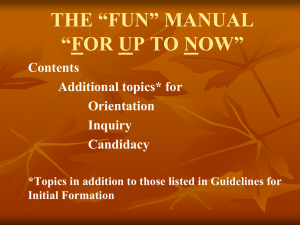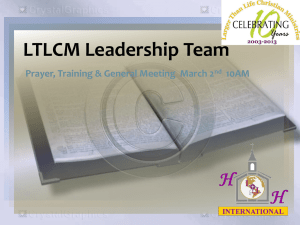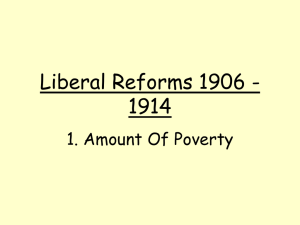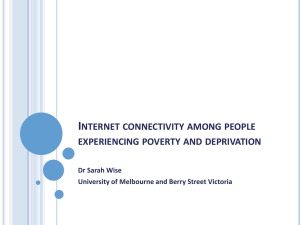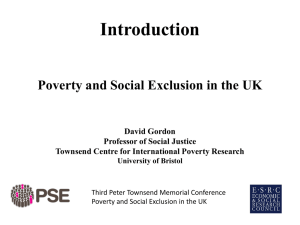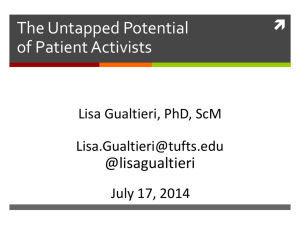Thomas Merton`s Paradoxical Contemplation and Social Action
advertisement
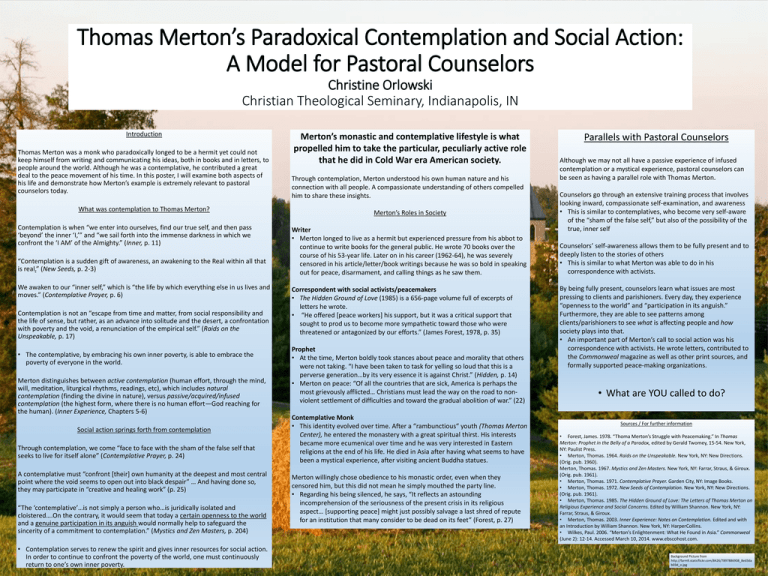
Thomas Merton’s Paradoxical Contemplation and Social Action: A Model for Pastoral Counselors Christine Orlowski Christian Theological Seminary, Indianapolis, IN Introduction Thomas Merton was a monk who paradoxically longed to be a hermit yet could not keep himself from writing and communicating his ideas, both in books and in letters, to people around the world. Although he was a contemplative, he contributed a great deal to the peace movement of his time. In this poster, I will examine both aspects of his life and demonstrate how Merton’s example is extremely relevant to pastoral counselors today. What was contemplation to Thomas Merton? Contemplation is when “we enter into ourselves, find our true self, and then pass ‘beyond’ the inner ‘I,’” and “we sail forth into the immense darkness in which we confront the ‘I AM’ of the Almighty.” (Inner, p. 11) “Contemplation is a sudden gift of awareness, an awakening to the Real within all that is real.” (New Seeds, p. 2-3) We awaken to our “inner self,” which is “the life by which everything else in us lives and moves.” (Contemplative Prayer, p. 6) Contemplation is not an “escape from time and matter, from social responsibility and the life of sense, but rather, as an advance into solitude and the desert, a confrontation with poverty and the void, a renunciation of the empirical self.” (Raids on the Unspeakable, p. 17) • The contemplative, by embracing his own inner poverty, is able to embrace the poverty of everyone in the world. Merton distinguishes between active contemplation (human effort, through the mind, will, meditation, liturgical rhythms, readings, etc), which includes natural contemplation (finding the divine in nature), versus passive/acquired/infused contemplation (the highest form, where there is no human effort—God reaching for the human). (Inner Experience, Chapters 5-6) Social action springs forth from contemplation Through contemplation, we come “face to face with the sham of the false self that seeks to live for itself alone” (Contemplative Prayer, p. 24) A contemplative must “confront [their] own humanity at the deepest and most central point where the void seems to open out into black despair” … And having done so, they may participate in “creative and healing work” (p. 25) “The ‘contemplative’…is not simply a person who…is juridically isolated and cloistered….On the contrary, it would seem that today a certain openness to the world and a genuine participation in its anguish would normally help to safeguard the sincerity of a commitment to contemplation.” (Mystics and Zen Masters, p. 204) • Contemplation serves to renew the spirit and gives inner resources for social action. In order to continue to confront the poverty of the world, one must continuously return to one’s own inner poverty. Merton’s monastic and contemplative lifestyle is what propelled him to take the particular, peculiarly active role that he did in Cold War era American society. Through contemplation, Merton understood his own human nature and his connection with all people. A compassionate understanding of others compelled him to share these insights. Merton’s Roles in Society Writer • Merton longed to live as a hermit but experienced pressure from his abbot to continue to write books for the general public. He wrote 70 books over the course of his 53-year life. Later on in his career (1962-64), he was severely censored in his article/letter/book writings because he was so bold in speaking out for peace, disarmament, and calling things as he saw them. Correspondent with social activists/peacemakers • The Hidden Ground of Love (1985) is a 656-page volume full of excerpts of letters he wrote. • “He offered [peace workers] his support, but it was a critical support that sought to prod us to become more sympathetic toward those who were threatened or antagonized by our efforts.” (James Forest, 1978, p. 35) Prophet • At the time, Merton boldly took stances about peace and morality that others were not taking. “I have been taken to task for yelling so loud that this is a perverse generation…by its very essence it is against Christ.” (Hidden, p. 14) • Merton on peace: “Of all the countries that are sick, America is perhaps the most grievously afflicted… Christians must lead the way on the road to nonviolent settlement of difficulties and toward the gradual abolition of war.” (22) Contemplative Monk • This identity evolved over time. After a “rambunctious“ youth (Thomas Merton Center), he entered the monastery with a great spiritual thirst. His interests became more ecumenical over time and he was very interested in Eastern religions at the end of his life. He died in Asia after having what seems to have been a mystical experience, after visiting ancient Buddha statues. Merton willingly chose obedience to his monastic order, even when they censored him, but this did not mean he simply mouthed the party line. • Regarding his being silenced, he says, “It reflects an astounding incomprehension of the seriousness of the present crisis in its religious aspect… [supporting peace] might just possibly salvage a last shred of repute for an institution that many consider to be dead on its feet” (Forest, p. 27) Parallels with Pastoral Counselors Although we may not all have a passive experience of infused contemplation or a mystical experience, pastoral counselors can be seen as having a parallel role with Thomas Merton. Counselors go through an extensive training process that involves looking inward, compassionate self-examination, and awareness • This is similar to contemplatives, who become very self-aware of the “sham of the false self,” but also of the possibility of the true, inner self Counselors’ self-awareness allows them to be fully present and to deeply listen to the stories of others • This is similar to what Merton was able to do in his correspondence with activists. By being fully present, counselors learn what issues are most pressing to clients and parishioners. Every day, they experience “openness to the world” and “participation in its anguish.” Furthermore, they are able to see patterns among clients/parishioners to see what is affecting people and how society plays into that. • An important part of Merton’s call to social action was his correspondence with activists. He wrote letters, contributed to the Commonweal magazine as well as other print sources, and formally supported peace-making organizations. • What are YOU called to do? Sources / For further information • Forest, James. 1978. “Thoma Merton’s Struggle with Peacemaking.” In Thomas Merton: Prophet in the Belly of a Paradox, edited by Gerald Twomey, 15-54. New York, NY: Paulist Press. • Merton, Thomas. 1964. Raids on the Unspeakable. New York, NY: New Directions. (Orig. pub. 1960). Merton, Thomas. 1967. Mystics and Zen Masters. New York, NY: Farrar, Straus, & Giroux. (Orig. pub. 1961). • Merton, Thomas. 1971. Contemplative Prayer. Garden City, NY: Image Books. • Merton, Thomas. 1972. New Seeds of Contemplation. New York, NY: New Directions. (Orig. pub. 1961). • Merton, Thomas. 1985. The Hidden Ground of Love: The Letters of Thomas Merton on Religious Experience and Social Concerns. Edited by William Shannon. New York, NY: Farrar, Straus, & Giroux. • Merton, Thomas. 2003. Inner Experience: Notes on Contemplation. Edited and with an Introduction by William Shannon. New York, NY: HarperCollins. • Wilkes, Paul. 2006. “Merton’s Enlightenment: What He Found in Asia.” Commonweal (June 2): 12-14. Accessed March 10, 2014. www.ebscohost.com. Background Picture from http://farm9.staticflickr.com/8426/7897886908_8ed3da b03d_o.jpg
